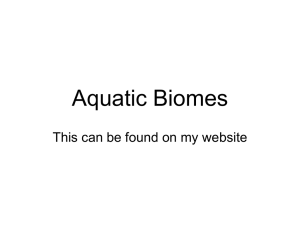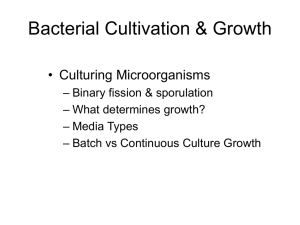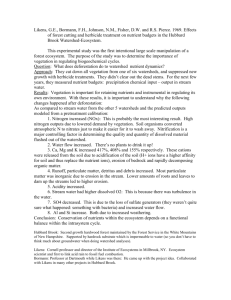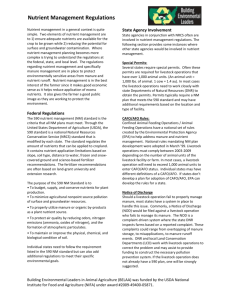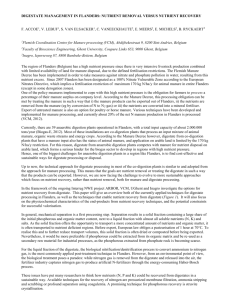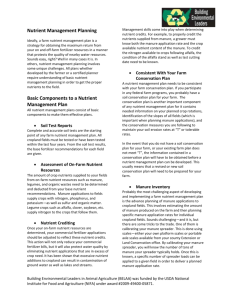Forestry workgroup 11-7-12
advertisement
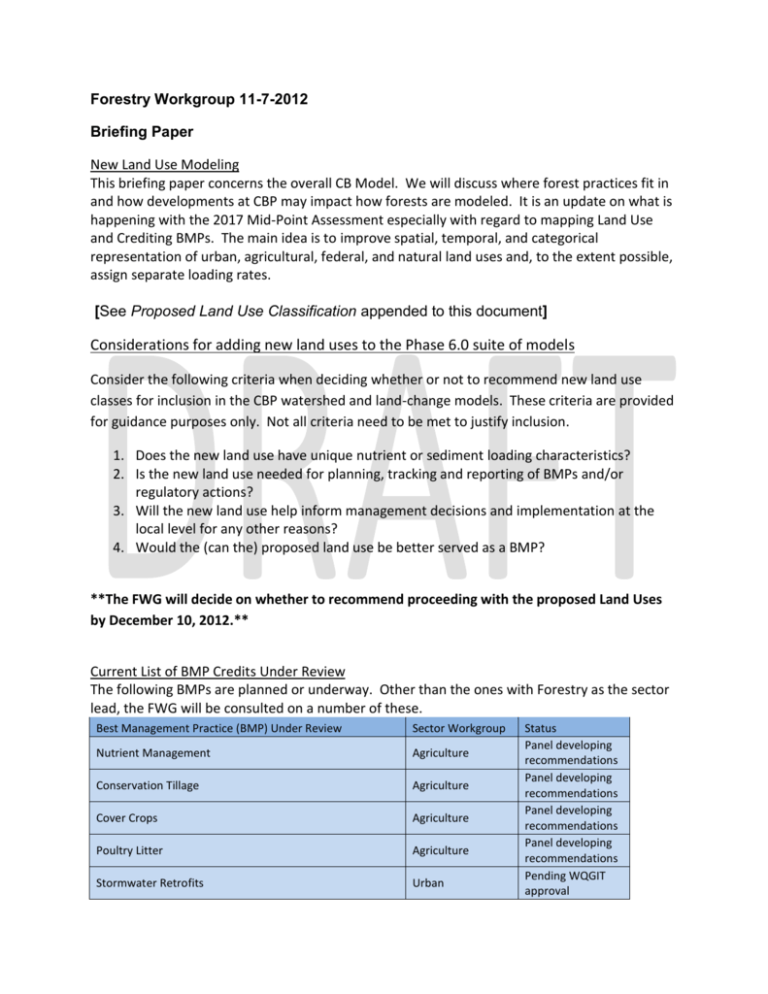
Forestry Workgroup 11-7-2012 Briefing Paper New Land Use Modeling This briefing paper concerns the overall CB Model. We will discuss where forest practices fit in and how developments at CBP may impact how forests are modeled. It is an update on what is happening with the 2017 Mid-Point Assessment especially with regard to mapping Land Use and Crediting BMPs. The main idea is to improve spatial, temporal, and categorical representation of urban, agricultural, federal, and natural land uses and, to the extent possible, assign separate loading rates. [See Proposed Land Use Classification appended to this document] Considerations for adding new land uses to the Phase 6.0 suite of models Consider the following criteria when deciding whether or not to recommend new land use classes for inclusion in the CBP watershed and land-change models. These criteria are provided for guidance purposes only. Not all criteria need to be met to justify inclusion. 1. Does the new land use have unique nutrient or sediment loading characteristics? 2. Is the new land use needed for planning, tracking and reporting of BMPs and/or regulatory actions? 3. Will the new land use help inform management decisions and implementation at the local level for any other reasons? 4. Would the (can the) proposed land use be better served as a BMP? **The FWG will decide on whether to recommend proceeding with the proposed Land Uses by December 10, 2012.** Current List of BMP Credits Under Review The following BMPs are planned or underway. Other than the ones with Forestry as the sector lead, the FWG will be consulted on a number of these. Best Management Practice (BMP) Under Review Sector Workgroup Nutrient Management Agriculture Conservation Tillage Agriculture Cover Crops Agriculture Poultry Litter Agriculture Stormwater Retrofits Urban Status Panel developing recommendations Panel developing recommendations Panel developing recommendations Panel developing recommendations Pending WQGIT approval Stream restoration (incl. Regenerative Conveyance Systems) New State Stormwater Performance Standards (for development and redevelopment) Urban Tree Planting Forest Erosion and Sediment Control (as proposed by WV) Urban Illicit Discharge Elimination Urban/Wastewater Septic, Part 2 (more broad view of systems) Wastewater Manure Treatment Technologies Agriculture Impervious Disconnect Urban Animal Waste Storage Systems Agriculture Liquid Manure Injection/Incorporation Agriculture Forest Management Forest Urban Filter Strips and Upgraded Stream Buffers Urban/Forest Floating Wetlands Urban Cropland Irrigation Management Agriculture MS4 Minimum Management Measures Urban Panel developing recommendations Pending WQGIT approval Panel developing recommendations Panel developing recommendations Panel developing recommendations Panel developing recommendations Panel convened (July 2012) Panel convened (July 2012) Planned (FallWinter 2012) Planned (FallWinter 2012) Planned (FallWinter 2012) Planned (FallWinter 2012) Planned (FallWinter 2012) Planned (FallWinter 2012) Planned (Spring 2013) Planned (Spring 2013) Planned (FY20132014) Planned (FY2014) Algal Turf Scrubbers Watershed Planned Urban Fertilizer Management On-site wastewater treatment systems (septic), Part 1 (review of efficiencies) Riparian Buffers (grass and forest) Urban Urban Urban Wastewater Forest Other planned activities involving the FWG in Mid-point Assessment work: Ongoing: Modeling Baseline/Input Data and Assumptions (permitted data e.g., MS4 and forest harvest data) January 2013: Revisit Watershed Model calibration methods with goal of improving local watershed results, including revisiting regional factors Summer 2013: Improved modeling accuracy of hydrologic networks, land use characteristics, phosphorus and sediment TBD: The CBP is considering a new modeling framework called PQUAL. The idea is to simplify the model (no more “black box”) without losing the scientific rigor involved. Initial DRAFT Land Use/Wastewater Classification for 2017 Mid-point Assessment (from Land Use Workgroup) 1. Developed a. Impervious developed i. Connected vs. Disconnected (connection via storm drain or proximity to waterway) 1. Regulated vs. Unregulated (inside vs outside MS4/CSO) a. Open space, Low-density Residential, High-density Residential, Mixed Commercial/Industrial/Residential, Institutional b. Pervious developed (e.g., turf grass, landscaped areas, and woodlands) i. Connected vs. Disconnected (connection via storm drain or proximity to waterway) 1. Regulated vs. Unregulated (inside vs outside MS4/CSO) a. Open space, Low-density Residential, High-density Residential, Mixed Commercial/Industrial/Residential, Institutional i. Turf vs Wooded 1. Turf fertilizer leaching and runoff risk categories (unfertilized, low risk, high risk based on soil and slope characteristics) 2. Urban tree canopy vs Rural woodlands c. Roads i. Urban/Suburban vs Rural 1. 1-lane, 2-lane, 4-6 lanes, 8+ lanes (to infer impervious area and size of medians and shoulders) ii. Federal vs. state vs. other (to assign responsibility) iii. Traffic volume ranges (linked to dry atmospheric deposition) d. Construction Note: Analyze sediment/erosion control permits and revisit current approach using annual change in impervious cover * factor representing disturbed acreage that is permitted. 2. Extractive a. Disturbed permitted acreage b. Distinguished by type: quarries/gravel pits, surface coal mines, and reclaimed mines c. Shale gas pads and associated infrastructure 3. Natural a. Upland Forests (with unmanaged understory- differentiated by species/age/”health”) i. Floodplain forests ii. Riparian forests iii. Harvested (undergoing managed succession) b. Lowlands/ wetlands (currently considered “Woody/Open” in Phase 5.3.2) i. Floodplain wetlands ii. Forested wetlands iii. Emergent/tidal wetlands c. Water (all non-tidal water area) 4. Agriculture Note: The classes below represent what is currently used in Phase 5.3.2. The Ag Workgroup is considering decoupling management systems from the crop types in the land use data. This would result in a simpler land use classification and just reflect major crop types derived from the NASS Cropland Data Layer and annual NASS reported acreages. a. High Till (i.e., conventional tillage) i. Manure (e.g., corn, soybeans, wheat, barley, dry beans, and more) 1. Nutrient management (request to drop this distinction) 2. No nutrient management ii. No manure (e.g., cotton, tobacco, Irish potatoes, orchards, and vegetables) 1. Propose revising this land use (VA comments) 2. Nutrient management (request to drop this distinction) 3. No nutrient management b. Low Till (i.e., conservation tillage) i. Manure (e.g., corn, soybeans, wheat, barley, dry beans, and more) ii. Nutrient management (request to drop this distinction) c. Hay i. Nutrients applied (e.g., tame and small grain hay, failed cropland) ii. No nutrients (e.g., wild hay, idle cropland, fallow land) iii. Nutrient management (request to drop this distinction) iv. Alfalfa 1. Nutrient management (request to drop this distinction) 2. No nutrient management d. Pasture i. Nutrient management (request to drop this distinction) ii. No nutrient management iii. Degraded riparian (i.e., unfenced riparian pasture) e. Nursery (separate in-house production from field rows) f. Animal Feeding Operations (converted to acres based on animal density assumptions) i. Regulated (CAFOs) ii. Unregulated (AFOs) 5. Wastewater a. Population on Sewer i. Improve maps of areas served by sewer and relate areas to individual plants and their efficiencies. b. Households on septic i. Distinguish different types of systems: commercial/retail, mass drain fields, failing systems, and direct discharges ii. Adjust soil attenuation rates based on distance to waterways iii. Examine relationship between household size assumptions, # of systems, and loads.




